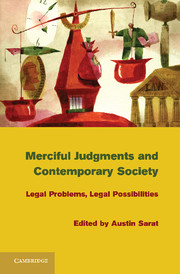Book contents
- Frontmatter
- Contents
- Acknowledgments
- Contributors
- When Can or Should Legal Judgment Be Merciful? An Introduction
- 1 The Place of Mercy in Legal Discourse
- Commentary on Chapter 1
- 2 Mercy, Crime Control, and Moral Credibility
- Commentary on Chapter 2
- 3 Defending a Role for Mercy in a Criminal Justice System
- Commentary on Chapter 3
- 4 Actions of Mercy
- Commentary on Chapter 4
- 5 A Feminist View of Mercy, Judgment, and the “Exception” in the Context of Transitional Justice
- Commentary on Chapter 5
- Index
Commentary on Chapter 3
Commentary on “Defending a Role for Mercy in a Criminal Justice System”
Published online by Cambridge University Press: 05 December 2011
- Frontmatter
- Contents
- Acknowledgments
- Contributors
- When Can or Should Legal Judgment Be Merciful? An Introduction
- 1 The Place of Mercy in Legal Discourse
- Commentary on Chapter 1
- 2 Mercy, Crime Control, and Moral Credibility
- Commentary on Chapter 2
- 3 Defending a Role for Mercy in a Criminal Justice System
- Commentary on Chapter 3
- 4 Actions of Mercy
- Commentary on Chapter 4
- 5 A Feminist View of Mercy, Judgment, and the “Exception” in the Context of Transitional Justice
- Commentary on Chapter 5
- Index
Summary
This commentary proceeds in two sections. Section I provides a brief overview of the authors’ excellent chapter. Section II offers two observations. The first observation looks at mercy in the context of white-collar crime. Because of its nuanced nature, the white-collar arena provides a rich context for many of the points made by the authors. The second observation addresses mercy at the level of the executive branch, rather than at the level of the judicial branch, which is the focus of the authors’ views on mercy. This commentary suggests that because of the amount of discretion executive branch officials have in criminal cases and the stage at which these officials exercise their discretion, there are more, and more diverse, opportunities for granting mercy in the executive branch rather than in the judicial branch.
Overview
“Defending a Role for Mercy in a Criminal Justice System” is a provocative and thoughtful piece. The authors define mercy as “mitigating the criminal's punishment” and offer guidance as to when the state should grant mercy. Key to the authors’ mercy paradigm is the concept of restorative signaling (RS), which the authors define as communicating to society that a criminal is now trustworthy to participate fully in society.
- Type
- Chapter
- Information
- Merciful Judgments and Contemporary SocietyLegal Problems, Legal Possibilities, pp. 195 - 204Publisher: Cambridge University PressPrint publication year: 2011



